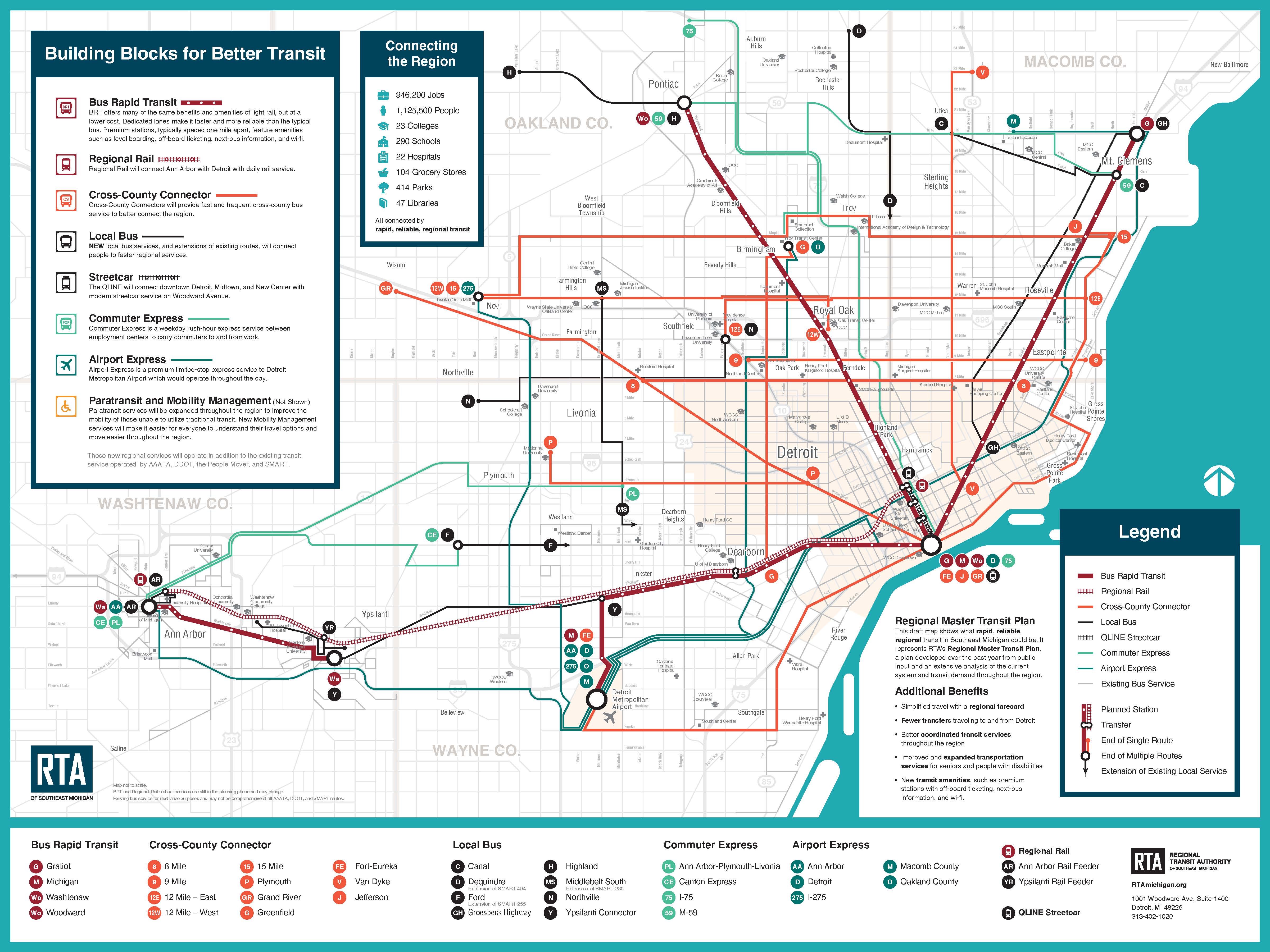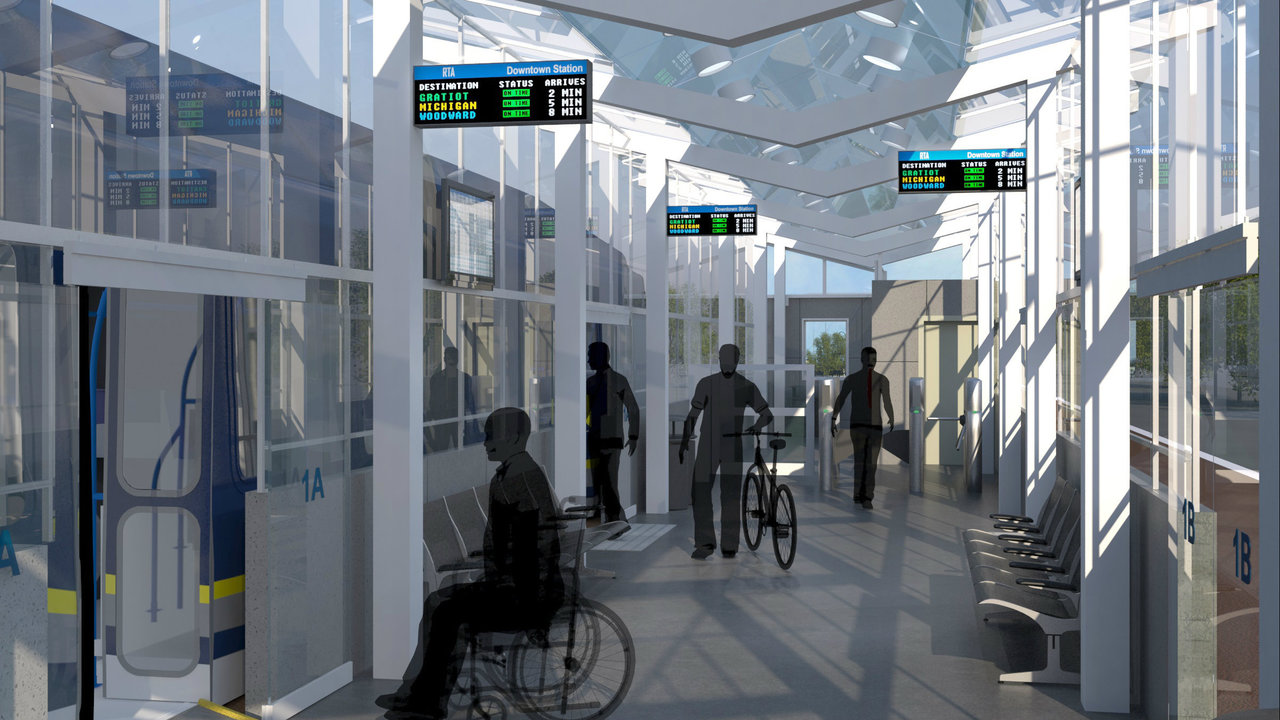DETROIT – More bus lines, a new rail connecting Detroit to Ann Arbor and more direct access to the airport all are part of an extensive plan for a public transportation system in southeast Michigan unveiled Tuesday by the Regional Transit Authority.
The RTA has spent the past year developing this plan to connect Wayne, Washtenaw, Oakland and Macomb counties with a transit system. The $4.6 billion master plan spans 20 years, beginning in 2017, with the majority of the system being created in the first five years of development.
View: RTA Implementation Timeline: 2017 - 2026
The RTA wants the system to work with existing regional transportation services including the Detroit Department of Transportation, the Suburban Mobility Authority for Regional Transportation, the Ann Arbor Transit Authority and Downtown Detroit's People Mover. The M-1 Rail streetcar (Q-Line), which is planned to open in 2017, will be folded into the RTA in 2024.
Watch: Transit system plan for Detroit area explained
"We're trying to connect the region," said Michael Ford, RTA's CEO. "Transportation is not connected in this region and we are responsible for connecting services in the four counties."
More: Breaking down RTA's proposal for Macomb County
Watch: Interview with RTA CEO Michael Ford
The RTA was created in 2012 to plan for and coordinate public transportation in the four-county region. It has a board whose 10 members are appointed for three-year terms by the county executives of Wayne, Oakland and Macomb counties, the chair of the Washtenaw County Board of Commissioners, the mayor of Detroit, and the governor of Michigan. The governor's appointee serves as chair and without a vote.
For more information, visit www.rtamichigan.org.
View a large version of the proposed plan map here. The map shows all the key elements to the plan listed below.
You also can print out a high-res map here.
Click this map to view the full-screen version:
Who is paying for this?
According to the RTA, the millage required to implement the $4.6 billion master plan is proposed as a 20-year millage (2017-2036) at 1.2 mills. This millage would be applied in addition to other possible state and federal funding sources, and would be about $7.92 per month for the average home in southeast Michigan.
Going to a vote:
Voters in Macomb, Oakland, Wayne and Washtenaw counties will be asked to consider the RTA millage proposal on Nov. 8, 2016.
Several community events are planned in the coming months. View a calendar of community RTA events here.
Read: How RTA's transit plan affects specific communities
Details: RTA transit plan: How much will it cost you?
More: Fares are unknowns in RTA's transit plan
"When we put this plan together, we were out for about 15 months hearing what people had to say, talking to the community, talking to the providers, doing market research, understanding what the needs are right now, what the emerging needs will be in the future, to help us really pinpoint where we need to make sure the service is really working well and where we can improve even more,” Ford said.
Key elements to the plan:
Bus Rapid Transit (BRT)
- BRT will offer the features of rail -- including dedicated lanes and large, well-designed stations – to provide fast and frequent connections and spark new economic development along our region’s main corridors. BRT is proposed on the following corridors:
- Woodward Avenue between downtown Detroit and Pontiac
- Gratiot Avenue between downtown Detroit and M-59
- Michigan Avenue between downtown Detroit and the Detroit Metro Airport
- Washtenaw Avenue between downtown Ann Arbor and downtown Ypsilanti
Regional Rail
- Ann Arbor to Detroit regional rail service will deliver a rapid transit link between Washtenaw and Wayne counties. Stations are planned in Ann Arbor, Ypsilanti, Wayne, Dearborn, and the Detroit New Center Amtrak station.
View: How RTA's transit plan links Ann Arbor to Detroit
Cross-County Connectors
- New Cross County Connector service will provide frequent, seamless service on our major regional routes significantly reducing the need for transfers between systems and long wait times. This service will be delivered as a partnership with the existing providers, building on and coordinating existing service.
- Cross County Connectors are planned for the following corridors:
- 12 Mile Road -- East
- 12 Mile Road -- West
- 15 Mile Road
- 8 Mile Road
- 9 Mile Road
- Grand River Avenue
- Greenfield Road
- Jefferson/Detroit
- Fort-Eureka
- Van Dyke
- Plymouth Road
Commuter Express
- Commuter Express service will offer high-quality, limited stop service to provide commuters a convenient new option to get to work. Planned routes include:
- M-59 with stops in Pontiac, Troy, Utica, and Mount Clemens
- Ann Arbor-Plymouth-Livonia new service
- Canton Express upgraded service between Ann Arbor and Canton
- I-75 from Auburn Hills to Detroit
Airport Express
- The airport express service is meant to provide comfortable, convenient and affordable express service to the airport from destinations throughout the region. Services to Detroit Metro Airport would be offered from:
- Ann Arbor
- Downtown Detroit
- Macomb County
- Oakland County
- I-275 (Oakland County)
- Ypsilanti
View: Getting to Detroit Metro Airport under RTA transit plan
New and Extended Local Service
- New/Extended Local Service will link communities and job centers with little or no transit service into the system to complete a regional network that truly connects our communities. The following routes are included in the plan:
- Canal
- Dequindre (Route 494) extension to Rochester
- Ford Road (Route 250) extension to Sheldon
- Groesbeck Highway
- Highland
- Middlebelt South (Route 280) extension to Farmington Hills
- Northville extension to Southfield
- Ypsilanti Local Connector
Paratransit/Mobility Management
- Mobility Management helps people understand their travel options and match users to the most appropriate travel choices available throughout the region regardless of what transportation provider is offering those services. The RTA program would increase spending on these services by 33 percent to better serve people in southeast Michigan who are unable to use regular transit services or where fixed-route transit service is not practical. The program will include a regional mobility management program, expansion of ADA and non-ADA Paratransit Services, on demand services, more coordination, innovative mobility solutions like partnerships with ridesharing for first mile and last mile connections and to serve hard to reach areas and a transportation demand management program.
Here is a rendering of what a RTA station would look like:




